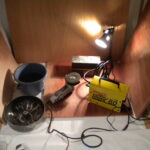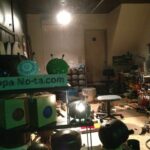― The Story Behind the Birth of Propanota ―
Chapter 1: Rhythm, Journey, and a Faint Glimpse of the Future
In my mid-twenties, I set out on a 2.5-year backpacking journey through Latin America.
Along the way, I often found myself deeply moved by the sounds of drums, the rhythms that echoed through street corners, and the bold, joyful music of the people.
After returning to Japan, I joined a fireworks company at the age of 30.
It was a world of gunpowder — dangerous and intense — but I felt pride and passion in the work of crafting something so beautiful, even if only for a fleeting moment.
I traveled across Japan and overseas, involved in both the manufacturing and launch of fireworks.
And yet, deep down, I carried a quiet thought:
“When I turn 40, I want to be standing in a completely different place.”
At the time, I had no idea that “different place” would be a life centered around creating musical instruments.
A fireworks festival in Tokyo. I like the fact that they are launched from a cylinder more than the fireworks themselves.
Chapter 2: A Seed of Sound, Sleeping Inside Steel
One day, I stumbled across a photo of a mysterious metal instrument — a round, disc-shaped drum.
It looked like something from outer space, and I was instantly captivated.
“Could I make this from a gas cylinder?”
That thought came naturally. Years earlier, I had used a gas canister to create an Udu drum — a clay pot percussion instrument from Africa.
At the fireworks company, used gas cylinders were everywhere. For me, they were the most familiar form of steel.
I first asked a local metal shop to help with the fabrication, but relying on others never quite brought the results I wanted.
So I made a decision: I’ll do it myself.
I converted a room in my small apartment into a workshop and began teaching myself metalworking — cutting, welding, and hammering to find sound.
The same hands that once handled explosives were now shaping music.
At 40, I realized what that “different place” had truly meant.
Not a career change within the fireworks world, but rather:
a life dedicated to crafting instruments that give birth to sound.
I left the fireworks company and committed fully to building Propanota.
It all started in this small space
Chapter 3: Crafting Sound to Meet the Unknown
Living off my savings, I poured everything into trial and error.
Back then, most tongue drums were limited to 8 notes — not enough for real melody.
So I developed a double-layered structure that allowed over 15 notes in a single instrument.
To showcase this, I gathered 50 people and had them play Ravel’s “Boléro” together.
The novelty of it drew media attention, but sales didn’t follow.
Still, my passion never wavered.
I created new models by adding noise to what was traditionally a “healing” instrument, making it capable of aggressive and expressive play.
I even developed an automatic playing device that lets the instrument resonate on its own.
Always seeking perspectives no one else dared to try — that has been my guiding light.
Though domestic sales in Japan didn’t grow as I’d hoped, I came to believe something with certainty:
These sounds are meant for curious, sensitive souls all around the world.
Even now, in the quiet of my workshop, I continue to face steel with care,
hoping that through sound, I might someday meet someone I’ve never seen before.
Please come and visit me when you come to Tokyo.
My English is like a baby’s. My Spanish is better.

